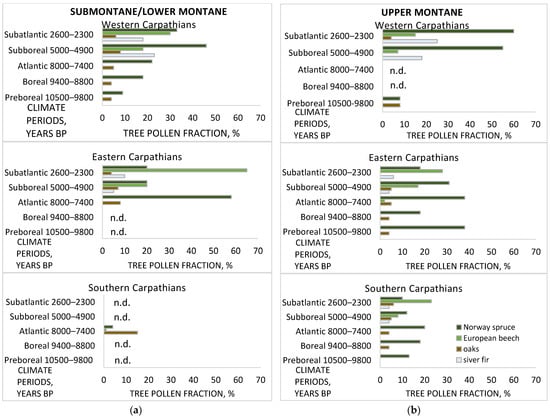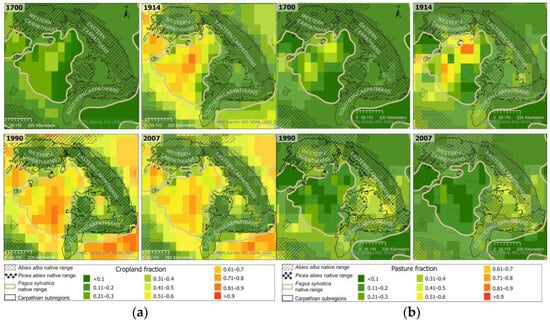The Carpathians are the second largest mountain range in Europe and provide multiple ecosystem services of enormous regional importance. The Carpathians belong to seven Central and Eastern European countries (Czech Republic, Slovakia, Poland, Hungary, Ukraine, Romania, and Serbia), whose share of forest land is among the lowest in Europe (27%). With a total area of 9.92 million hectares, Carpathian forests constitute over 70% of the total forested land in Slovakia and Romania, with Romania alone harboring more than 45% of all Carpathian forests. Most of the Carpathian forests are dominated by European beech (Fagus sylvatica), Norway spruce (Picea abies), oak (Quercus robur, Quercus petraea), and silver fir (Abies alba) stands, covering over 70% of the altitudinal range (with the highest point being Gerlachovský štít, 2655 m a.s.l., in the Slovakian Tatra Mountains). The Carpathian Mountains were characterized in terms of their forests in the period starting from Holocene deglaciation. Climate fluctuations and human activities have led to substantial changes in forest systems, and anthropogenic activities, such as logging, fire activities, and grazing, have shaped the distribution and structure of present-day Carpathian forests. The rapid climate change in recent decades adds uncertainty to the future development of these forest systems.
1. From the Holocene to the Anthropocene
In the Holocene, deglaciation was followed by substantial forest expansion in the Carpathians. Increasing temperatures (up to +10 °C at higher elevations) led to an upward shift of the treeline, with the glacial refugees Scots pine (
Pinus sylvestris) and larch (
Larix decidua) reaching more than 2000 m (present limit: 1200 to 1900 m
[1][2][40,41]) in the Early Holocene (11,500–8000 years ago
[3][4][5][6][42,43,44,45]). In the foothills, the warming enabled the spread of mixed oak stands
[7][46]. In the Preboreal and the especially warm and humid Atlantic climatic phase, early coniferous and broadleaf successors were continuously replaced by Norway spruce (exceeding 60% in proportion), silver fir, European beech, and hornbeam (
Carpinus betulus)
[3][8][9][42,47,48] (
Figure 1). Due to their higher shade tolerance, especially silver fir and beech were competitive compared with early conifer successors
[10][49]. The competition in dense mixed stands also favoured beech over Norway spruce, resulting in beech-dominated forests up to 1000 m. This transition started earlier (around 5200 years ago) in the Western and Eastern Carpathians and later (around 4000 years ago) in the Southern Carpathians
[4][11][12][43,50,51].
Figure 1. Holocene evolution of tree species which are dominant in present-day Carpathian forests: (
a) submontane and lower montane zones; (
b) upper montane zones. The pollen fraction is the averaged fraction of tree pollen (%) calculated from pollen analyses of 30 studies in total
[4][5][9][10][11][12][13][14][15][16][17][18][19][20][21][22][23][24][25][26][27][28][29][30][31][32][33][34][35][36][19,20,21,43,44,48,49,50,51,52,53,54,55,56,57,58,59,60,61,62,63,64,65,66,67,68,69,70,71,72] (Supplementary List S2). The pollen fraction of forest tree species for the Subatlantic period is based on the time before the 16
th century. For some periods, no data (n.d.) are available. The location of the case studies is given in
the Supplementary Material (can be downloaded at: https://wwwSupplementary Figure S4.
mdpi.com/article/10.3390/f15010065/s1.)
In the Late Bronze and Early Iron Ages, human activity became the main factor for the further development of Carpathian forests. The use of timber led to the lowering of the treeline (amplified by declining summer temperatures
[2][41]), and at lower elevations, oak was intensively logged due to settlement and agricultural expansion, though forest openings contributed to its regeneration
[4][43]. European beech and silver fir populations expanded, whereas silver fir especially benefited from fire activities due to the colonialization of burned areas
[14][19][20,55]. Anthropogenic influence (e.g., fire, logging, grazing) continued to be the dominating factor of development in the Late Iron Age and the Roman Age. In the late Middle Ages, mining and the Walachian colonization led to a dramatic transformation of Carpathian forests by humans: it resulted in a massive decrease in forest areas in the 14
th–15
th centuries in the Western Carpathians
[15][37][38][21,73,74] and the Eastern Carpathians
[14][30][39][40][20,66,75,76] and in the 16
th and 17
th centuries in the Southern Carpathians
[41][77]. Intensive use of wood for construction led to a decrease in the proportion of both deciduous (European beech, required, e.g., for potash production
[42][43][78,79]) and coniferous (silver fir and Norway spruce) trees
[14][20], while oak forests expanded
[30][66]. However, silver fir stands also regenerated in many Carpathian forests, probably due to favourable conditions for this species’ growth after grazing activities, the predominant logging of European beech in the times of intense colonization, and litter raking
[27][44][45][46][63,80,81,82].
Intense forest exploitation continued into the times of the Austro-Hungarian Monarchy (from the late 18
th to the beginning of the 20
th century) when the biggest decrease in Carpathian forest cover was reported
[47][48][49][50][51][83,84,85,86,87]. The Western Carpathians were at the forefront of changes caused by cropland expansion into the mountain areas of native ranges for European beech and Norway spruce (
Figure 2). For the sake of increasing timber yields, Norway spruce was favoured, as it allowed for shorter rotation periods and provided wood of good quality and manifold usability. This resulted in monodominant forests in many regions. Consequently, these forests were very vulnerable to severe disturbances (windstorms, bark beetle outbreaks), aggravated by extreme cold periods in the Late Little Ice Period
[31][52][67,88], with the most pronounced effects in the 19
th century
[53][89] and peaks in the periods from 1830 to 1850 and from 1860 to 1880 in the Western and Eastern Carpathians
[54][55][56][57][90,91,92,93] and from 1880 to 1910 in the Southern Carpathians
[58][94]. As a result, the lowest point in forest cover occurred in the 1920s
[59][95].
Figure 2. Cropland (
a) and pasture (
b) dynamics (created using the data from
[60][96]) and native ranges of dominant forest tree species (data from
[61][97]) in the Carpathians between 1700 and 2007.
In the 20th century, climatic conditions stabilized, and the Carpathian forest area increased between the two World Wars
[62][63][98,99]. The latter went together with chaotic reforestation following land abandonment because of diverse land use decisions due to ownership changes, and asynchronous political and socio-cultural developments throughout the Carpathian countries
[64][65][66][100,101,102].
2. Recent Developments
The political situation after World War II led to major socio-economic changes in Central and Eastern Europe, also resulting in land use changes in the Carpathians. The land use regimes shifted from agriculturally dominated to forest-dominated structures, and accordingly, agricultural land abandonment has become the common driver of the recent forest cover increase in the Carpathians (e.g., an increase of 6% in the Polish Carpathians from 1990 to 2012
[67][103]). This process took place especially in depopulated regions
[68][69][104,105], in areas less suitable for agriculture, and at higher and steeper elevations
[70][71][106,107]. At the same time, the artificial increase in Norway spruce forests (by 46% in the Southern Carpathians
[72][108]), a profound decrease in silver fir stands (by up to 39% in the Ukrainian Carpathians
[73][109]), and the tendency towards European beech dominance were characteristic of the postwar period. After 1990, the social and economic conditions in the transition period toward market economies, such as decreasing profitability of agriculture and improved possibilities for employment in industrial centres or tourism and recreation services, fostered further land abandonment
[74][75][76][77][110,111,112,113]. Accordingly, in Poland, Slovakia, and the Czech Republic, where post-socialist land reforms and support from the European Union were adopted early, the rate of agricultural land abandonment (cropland and pasture reduction) and the respective increase in forest area within the Carpathian Mountains were the most pronounced
[50][75][78][79][86,111,114,115]. In contrast, the forest area in the Romanian Carpathians, even in the first decade of the 21st century, was still shaped by grazing (
Figure 2).
Land abandonment is also the main driver of the recent altitudinal forest expansion
[80][81][82][116,117,118], supported by a prolonged vegetation period due to global warming
[83][119], as well as protection measures (see, e.g.,
[80][84][116,120]). The altitudinal forest expansion was the most pronounced in recent decades, with an average upward shift of 0.5–1 m per year
[85][86][121,122].
In contrast to the quantitative increase (in terms of forest area or timber production) in Carpathian forests, their qualitative development (in terms of forest vitality or structure) was hindered by unfavourable forest practices, like large-area deforestation (e.g., a 6% decrease in afforested area in the period from 1990 to 2012 in the Romanian Carpathians
[87][123]), fragmentation, decrease in core forests (i.e., increase in the patch and perforated forest), and homogenization in species and age structures
[49][88][89][85,124,125]. Rapid modification of regulations in the post-socialist period resulted in liberalized deforestation regulations across the region. As early as the transition years (1988–1994), harvesting almost doubled in Ukraine, Poland, and Slovakia
[90][126]. The ownership recovery process and massive forest restitution to private owners contributed to both legal and illegal logging, mostly in the Eastern and Southern Carpathians
[91][92][93][94][127,128,129,130]). In the Romanian Carpathians, deforestation intensified after the restitution laws of 1991, 2000, and 2005, resulting in a loss of 4.5% in the total forest area and disturbances (windthrows, droughts, bark beetle outbreaks) occurring more often
[88][95][96][97][124,131,132,133]. Significant forest disturbances after 2000, with almost 20% of forests being affected, were also found in the Polish, Slovakian, and Czech Carpathians
[98][134]. For instance, this also caused a cascade of disturbances in High Tatra Mountain Norway spruce forests as a consequence: a severe drought in 2003, followed by bark beetle infestation; the Elisabeth windstorm in 2004, followed by deforestation, fragmentation, and bark beetle outbreak; Kyrill and Phillip windstorms (2007), followed by deforestation; bark beetle infestation peak (2009) and clear-cut logging (2009–2012). These events led to a 54% decrease in the national park forest area from 2002 to 2018
[99][100][135,136], with the biggest damage being caused to the treeline
[101][137]. Forest disturbances were observed in all ownership types, although disturbance rates in private forests were about five times higher than on public lands, and these forests were more fragmented than state and national park forests
[102][23]. Additionally, wind and snowstorm disturbances were particularly destructive in forests, whose composition was artificially changed towards monocultures through clear-cutting
[94][130].
Air pollution (peaking in the 1980s and 1990s), causing acid rain and photochemical pollution (reaction of nitrogen oxides and volatile organic compounds induced by sunlight), directly affected trees (needle yellowing) and increased the susceptibility of trees to pests
[103][104][105][106][138,139,140,141]. The pollution effect was aggravated by the elevated concentrations of ozone in large parts of the Carpathian Mountains
[103][104][105][107][108][138,139,140,142,143]. Despite reduced industrial emissions in the late 1990s, high levels of tree defoliation in forests in Poland, the Czech Republic, Slovakia, and Hungary were observed for years
[106][109][110][111][141,144,145,146], most probably hindering regeneration and upward expansion (e.g., of silver fir;
[112][147]) and contributing to Norway spruce dieback
[113][148]. Improved emission regulations and technical developments enabled a significant decrease in pollutant loads on forests by the end of the 20th century. However, other abiotic factors, such as droughts, wind, frost, and snow/ice damage, and biotic factors (e.g., insect invasions) are the main reasons for tree damage in Carpathian forests
[114][115][116][117][118][149,150,151,152,153], and current and future developments related to climate change are the main challenges for forest management in the Carpathian Mountains.


